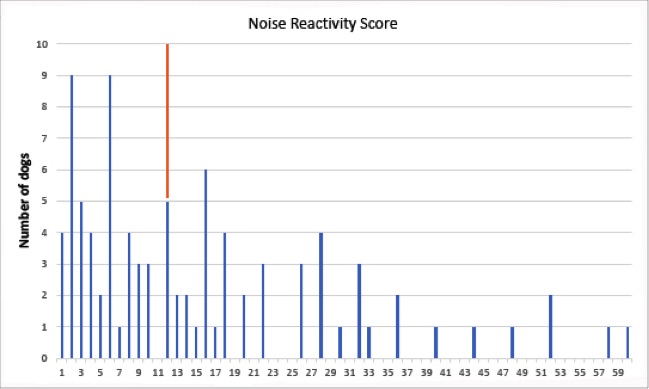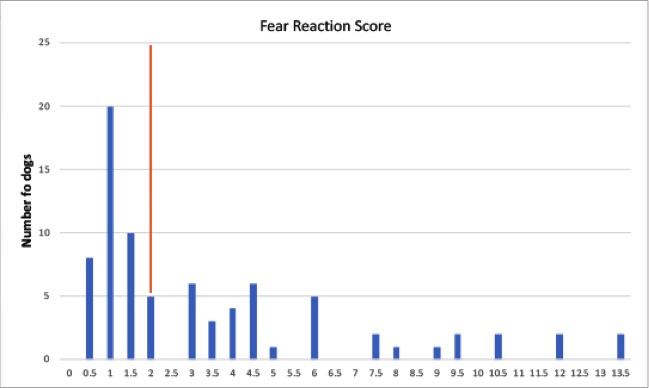
animal health consulting
The highly sensitive dog
making life easier for these wonderful dogs
Christine King BVSc, MANZCVS (equine), MVetClinStud
(Page 2 of 5)
(back to Page 1)
Sticking with the study data for the present, it’s worth noting that most of the dogs in the noise sensitive (NS) group were mildly or moderately noise sensitive; only some were extremely reactive (Figure 1).

Figure 1. Noise reactivity scores for the 91 dogs in the Noise Sensitivity group. The median score (orange line) was 12, where 1 is slightly reactive and 60 is extremely reactive.
(The median is the value which splits the group into equal halves, so 50% are at or above this line and the other 50% are at or below this line. Even though it looks like there are more dogs on the right side of this line, 50% of the dogs had noise reactivity scores of 12 or less.)
In other words, all 91 dogs in the NS group were identified by the behavioural questionnaire as being abnormally reactive to loud noises, but there was a wide range of reactivity within the group, and most were at the lower end of the spectrum.
(Note: all of the dogs in the Control group scored a solid 0 for their Noise Reactivity Score.)
Likewise, most of the dogs in the fear reaction (FR) group were mildly or moderately fearful toward strangers or new situations; only some were extremely reactive (Figure 2).

Figure 2. Fear reaction scores for the 80 dogs in the Fear Reaction group. The median score (orange line) was 2, where 0.5 is slightly reactive and 13.5 is extremely reactive.
(The scale of the fear reaction score is very different from that of the noise reactivity score because fewer questions were asked and fewer options were available for response, so the maximum possible FR score was much lower than that for the noise reactivity score.)
In statistical terms, neither of these two groups (NS and FR) were ‘normally distributed,’ meaning that the reactivity scores did not form the classical bell curve around the average score for the group. These data and their skewed distribution suggest two things:
1. Whether the trigger is loud noises or strange people/situations (or both!), ‘reactive’ dogs are not a homogeneous or uniform group of ‘misfits’ or ‘maladapts’.
2. Most reactive dogs are likely to respond well to positive training, careful management of their environments, and, when needed, behaviour-modifying therapies. Even those who are extremely reactive can become much less so with these sensitivity-aware approaches.
These two points are interrelated, so I’ll discuss them together as we head toward practical strategies for managing these dogs.
Let’s start with the notion that there’s something wrong with these ‘reactive’ dogs — that they’re genetic misfits or they’ve been poorly brought up or poorly trained.
Our genes are not our destiny
Contrary to popular opinion, our genes are not our destiny. We are constrained by our genetic inheritance, but not as much as we’ve been taught, and not as much as we might suppose by looking only at the genes which code for the relatively immutable physical characteristics such as eye colour or hair colour.
(That said, eye colour can change, particularly with disease; and as anyone over the age of about 30 can attest, hair colour changes over time. But I digress...)
We remain physiologically and psychologically adaptable throughout life. This is a characteristic of all biological systems, and it’s where the rather brutalist saying “adapt or die” originates.
The activity of many — in fact, most — of our genes is very ‘fluid’ and contextual (depends on the context). Our systems are constantly perceiving and responding to our environments, inside and out, even while we sleep. Through this ability of our genes to alter their expression according to circumstances, our systems are both responsive (short-term) and adaptive (long-term) throughout our lifetime.
In practical terms, while you may have a highly sensitive dog, the expression of that sensitivity can vary. It can be heightened by negative experiences (including punishment for reactivity), and it can be lessened by positive experiences (including praise for remaining calm). For example, noise-sensitive dogs will still be sensitive to loud noises, but the degree to which they are distressed and therefore react to loud noises can be lessened.
Eustress vs. distress
A useful concept here is the expanded definition of stress as being either eustress (‘good’ stress) or distress (‘bad’ stress).
With eustress, the stressful event or situation is of a low enough intensity or duration that we are able to respond to it without harm, and as a result we adapt, thereby increasing our capacity to cope with such events or situations in the future. This type of stress is adaptive, so it may be seen as generally positive or beneficial.
Distress, on the other hand, is stress of sufficient intensity or duration that it overwhelms our present capacity to respond. It may cause harm, and in so doing can actually decrease our capacity to respond and to adapt, as we hunker down in ‘defense’ mode and ride it out the best we can. The next time we encounter this stressful event or situation, we react sooner and with greater intensity, as a defensive mechanism. This type of stress is maladaptive, so it may be seen as generally negative or harmful.
High sensory-processing sensitivity has its positive aspects. For example, highly sensitive dogs generally make wonderful companions. The downside is that they are more easily overwhelmed than less sensitive dogs. The trick, then, is to manage the stresses that are inevitable in every life and ensure that, most of the time, the stress the dog experiences is eustress (tolerable, adaptive) and not distress (intolerable, maladaptive).
This Finnish study was designed, in some respects, as a canine model for human neuropsychiatric disorders. So, let’s turn that back around and take a look at these canine behavioural problems — and their possible solutions — in light of our human experience.
In my view, the essential premise of managing these highly sensitive dogs is this:
Respect your dog’s sensitivity, while gently working to reduce reactivity.
If, as this and other animal and human studies indicate, high sensory-processing sensitivity is an inherent behavioural trait rather than a disorder, then your dog will remain highly sensitive. However, your dog needn’t remain highly reactive.
Next, some practical suggestions.
© Christine M. King, 2019, 2022. All rights reserved.
First published on WordPress, 03 Feb 2019.
(to articles main page)